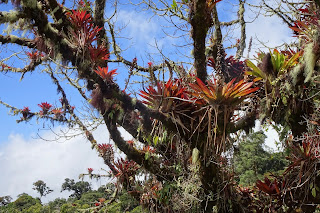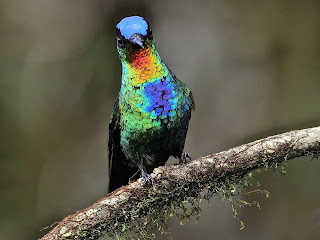This week, Dr. Robert Fleming transports us to the sight of an impressive ecotourism venture in Costa Rica…
 |
|
The grounds of the Paraiso Quetzal Lodge. Each bungalow features a bedroom and an attached bathroom with solar-heated water. At 9,0000 feet altitude, nights can be cold (down to 5 degrees C or below) so hot water and extra quilts are much appreciated. The property is landscaped with plants that attract a variety of mountain birds including the Black-and-yellow Silky Flycatcher.
|
As we sipped hot morning coffee at the Paraiso Quetzal Lodge on the Cerro del Muerte uplift in central Costa Rica, a cloud oozed over the ridge and pushed down the western slope enveloping us in fog. But even through the mist we could make out forms of hummingbirds buzzing by and see the outlines of nearby oaks, their nearly horizontal branches seemingly decorated by a master gardener. Only oaks and similar trees with strong branch attachments can survive these conditions as the weight of the bromeliads, ferns, lichens, orchids and mosses, among others, combined with the moisture from mist and rain would spell disaster for trees with weaker joints. This was a classical cloud forest, a habitat type found at moderate elevations on many mountain slopes and ridge tops around the world…
We had traveled to Costa Rica to learn about the country’s remarkable conservation efforts and to delve into their rich natural history. And at every turn, whether in a garden or cloud forest, birds vied for attention. Not surprising as the country lists some 900 species ranging from huge-beaked Toucans to the diminutive Green Thorntail, which weighs just 3 grams, 1/10th of an ounce. Besides birds, Costa Rica hosts mammals, reptiles, frogs and many varieties of butterflies. And in the plant world, Costa Rica is home to well over a thousand species of orchids, including the national flower Guaria Morada (Cattleya skinneri).
One of the grandest of all Costa Rican species is surely the Resplendent Quetzal (Pharomachrus mocinno), a bird in the Trogon family. Other species also attract, but this quetzal with its iridescent green upper body and bright red underparts is unmatched. And the males in full plumage sport two elongated tail feathers that shimmer an iridescent green when waving back and forth in breezes of the forest.
 |
| The Resplendent Quetzal (Pharomachrus mocinno) is the largest member of the Trogons, a family of forest birds featuring some thirty species in the tropical Americas, a dozen in tropical Asia, and three in Africa. Large trogons, such as this Resplendent Quetzal, feed primarily on fruit while the smaller ones, including the Scarlet-rumped in Southeast Asia, consume mostly insects, including caterpillars and other larva. Trogons are indicator species as they are very sensitive to deforestation, and their presence speaks of good forest conditions as they are cavity nesters, excavating their own nest holes mostly in suitably decaying tree trunks, and thus require trees of a suitable size age and size. |
Conservation efforts often center around habitat protection, places where species can feed, find shelter, and locate suitable nesting or denning sites. And one of the many instruments within the conservation toolbox is the use of a charismatic species to help rally financial and emotional support. The Resplendent Quetzal of Central America, the Mountain Gorilla in Uganda, or the tiger in India fit into this category. But whether or not a charismatic species is present in a region, the key operative is habitat preservation, an effort that benefits all species within that designated territory.
Costa Rica is one of the world’s leaders in the total area of the country under conservation surveillance with a figure that normally appears to be between 26% to 28% in a patchwork of government sponsored national parks, preserves and wildlife refuges along with a network of private preserve, some quite extensive that often border on government parks. Of the lowland tropical forest, some 80% is now under protection. In addition, there are on-going discussions regarding adding more corridors between protected areas to enhance wildlife travel. While all these areas look good on paper, some have encroachment problems. However, one needs to start somewhere and designating an area as protected is a good way to begin.
It was not always this way. Between 1950 and 1990, Costa Rica lost 65% of its forest cover due to clearing for commercial crops (mostly coffee and bananas), cattle ranching, and forest exploitation. Conservation endeavors began in the 1950, but much of the groundwork for today’s system was laid after 1960. Then, in the 1980s, the protecting of Costa Rica’s natural heritage accompanied by publicity fueled an ecotourism boom. Today programs have become so successful that in some places the flora and fauna that attracts visitors in the first place teeters on the edge of being overwhelmed (for more information see The Green Republic: A Conservation History of Costa Rica, by Stirling Evan; Duke University Press.).
Our visit to Costa Rica included time on the Cerro del Muerte uplift southeast of San Jose, where we stopped at Paraiso Quetzal, a lodge with fourteen bungalows located at an altitude of 2100m (9,000ft). Here we met Jorge Serrano Salazar and learned of his family’s splendid ecotourism effort, a program that involves members of the community living along the Pan American Highway in the Tres de Junio area.
 |
|
Jorge Serrano Salazar (pictured right) is the visionary behind
Paraiso Quetzal Lodge. He is also the general manager and
stands with this cousin, Jairo Serrano, behind the reception desk.
This is a family run operation with various members assisting as needed.
|
Jorge, a member of the extensive Serrano family, grew up in quetzal country and while studying rural tourism at his local high school, realized that showing quetzals to visitors could be a key income generating opportunity for the family – if only they could work out a system.
‘Quetzal tours’ were already in vogue in other quetzal hot spots such as Savegre Valley and Monteverde. Eager to see one of these birds, we visited the Savegre Valley where we engaged Marino Chacon as our driver/guide. Early one February morning he drove us slowly up the main road from the Savegre Lodge until he heard a bird and then quickly spotted a fine male sitting on a moss-covered branch in the cloud forest. There, in front of us, was an experience we will long remember: the classical image of a stunning quetzal.
When one party locates a quetzal along the Savegre Valley road, other hopefuls gather. And this morning, with two males spotted in this sector, I noted that forty-seven other participants had assembled, all straining for glimpses of an iridescent green back or a red belly in the openings between oak leaves. The folks at the front of the crowd were all smiles while those in the back were likely not as lucky until they moved forward.
Thinking about the competition from these semi-zoos, Jorge needed a plan. First, he needed quetzals – which he had. Then he needed an infrastructure – which he did not have. And finally he needed viewers.
What better way to attract visitors to a special habitat than to build a place right on the spot? Pooling money, the family opened a small restaurant in 2005. This was so successful that in 2007 they expanded the main building and added three bungalows, enabling visitors to stay longer. And while constructing a restaurant and three bungalows was all well and good, this was not enough – quetzals do not feed in the dinning room. Jorge needed to develop a system to show quetzals to guests.
And then inspiration hit.
Quetzals live in mountain oak forests but fortunately are quite flexible, as a good portion of the original forest around Esperanza, a small town near the Paraiso Quetzal Lodge, has been cleared for agriculture or animal husbandry. Small holders now privately own this land, often a farming family working from 2 to 10 hectares. As the altitude around Esperanza is too high and damp for coffee, the farmers raise raspberries, potatoes, and other cold weather cash crops; most farmers also own two or three milking cows.
 |
|
In a cloud forest, both rain and moisture from clouds is needed for the survival of epiphytic bromeliads such as these found on horizontal surfaces of oaks and other tree branches, usually sharing the surface with, lichens, ferns, mosses, orchids, and other plants. Curiously, bromeliads can occasionally take hold on power lines, a behavior rarely seen in other plant groups. Trees in these mountain forests need to have sturdy branch attachments in order to withstand the weight of the bromeliads, ferns, and orchids all soaked with heavy rain. The tree pictured here grew just northwest of the lodge dinning room.
|
In 2009 Jorge started his scheme by coaxing local farmers to search their property each morning, looking for quetzals, and should they find a bird, report to the lodge on their cell phones. Quetzals feed on wild fruit – especially wild avocados – as well as on frogs and lizards (during the rainy season) and once breakfast is ingested they usually sit quietly on a branch for extended periods. Thus guests at the lodge who are interested – and have paid a substantial fee – climb aboard a vehicle for a ride of fifteen or so minutes to the selected farm. Once you know where a bird is resting, the chances of arriving guests seeing a quetzal is high. Another seasonal method of locating quetzals, and one popular along main roads, is to find a nest with chicks and then watch the adult birds coming and going. The nesting season on the Pacific side of the Cerro del Muerte uplift normally begins early in March and lasts into May.
 |
|
The lodge’s mission statement speaks to the importance
of taking pride in caring for Mother Nature for future generations.
|
Jorge’s program, started with only two farmers, but now has become so successful that his list of reporting individuals has grown to twenty-two with two more waiting in the wings. In the high season, the lodge runs three ‘quetzal tours’ a day, each with a limit of ~6 people per group. It is mportant to limit the number of visitors to any one site, Jorge says, so as not to overly disturb the birds. Evidence of the success of this program is that some farmers are now planting wild avocados and other fruit-bearing trees on their properties.
Most effective ecotourism efforts involve a number of steps and players. And Jorge’s program, while not replicable everywhere, certainly exhibits some components of a successful ecotourism project. First, a species or an area of special interest (such as a sacred mountain) is identified. Then a project needs a visionary person to propose a plan and who is willing to devote resources and time to the effort. In addition, there is the infrastructure. Visitors need to be able to reach the site and, where possible, have a place to stay. In addition, personable guides trained in natural history are a must. Also an enticing website is a distinct plus as this is a most useful tool for drawing attention to the site.
Costa Rica is located reasonably near the large North American market. This is fortunate, but an ecotourism program that depends on international guests is not totally reliable as world affairs influences travel. Thus it is best to cater to a steady stream of local citizens and, as available, add foreigners to the mix. The Serrano family benefits from being only three hours drive from the capital San Jose, and within a six-hour drive of close to half of Costa Rica’s population.
And the family also profits not only from the quetzal but also from the quiet and peaceful nature of its oak forest location, one that overlooks a fine view towards the Pacific. Thus staying here makes for splendid interlude from the hustle and bustle of San Jose, Cartago, and other cities. Moreover in addition to the quetzal, hosts of hummingbirds buzz around the grounds and these, along with other mountain species, make Pariso Quetzal an ideal stopover for birders, international or otherwise.
 |
This Firey-throated Hummingbird (Panterpe insignis), one of 54 Costa Rican hummingbird species, was photographed at the Paraiso Quetzal Lodge. This is a montane resident usually found above 2000m (6,600’) altitude in central and southern Costa Rica and into extreme western Panama. The Firey-throated is a nectar feeder, sometimes probing for food at the bases of a bromeliad flowers by utiizing holes originally made by bees. Hummingbirds also consume insects and spiders as a source of protein and are so agile that they have no trouble darting into the air to catch a flying morsel
|
Above all, sustainable ecotourism projects revolve around enhancing the participation of local communities. If the local residents see financial benefits, they are ones who are most likely to best safeguard the resource. And we see in the Tres de Junio area where, thanks to the Serrano initiative, farmers are now aware of the advantage of maintaining their environment and augmenting their quetzal habitat.
Jorge and the Serrano family are to be congratulated on their on-going conservation success.
_________________________________________________________
|
|
|
Dr. Fleming with naturalist/guide Alanzo (pictured right), Quetzal showing
farmer William (left) and Serrano family member (far left); photo
taken by James Regali, Bob’s companion on the Quetzal search.
|
This week’s blog piece and photos make up the third installment in our Musings of a Naturalist series, courtesy of our own Dr. Robert (Bob) Fleming: Professor Equity and Empowerment/ Natural History. Having grown up in the foothills of the Himalayas in India, Bob has long been interested in the beauty of nature. This progressed into a fascination with natural history and cultural diversity, leading him to obtain his Ph.D. in zoology. He has explored many of the planet’s special biological regions, ranging from the Namib Desert in Africa to the Tropical Rainforest of the Amazon, and the Mountain Tundra biome of the Himalayas. He has worked for the Smithsonian’s Office of Ecology and the Royal Nepal Academy and, along with his father and Royal Nepal Academy Director-Lain Singh Bangdel, he wrote and illustrated “Birds of Nepal,” the first modern field guide to the birds of the region. In addition to his work with Future Generations, Bob is the director of Nature Himalayas, a sole proprietorship that he began in 1970. Through this company, Bob has led some 250 outings. He currently lives in the temperate rainforest of western Oregon in the USA’s Pacific Northwest.
Many thanks to Dr. Fleming for another great contribution!









